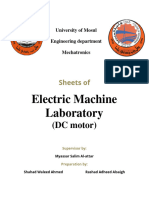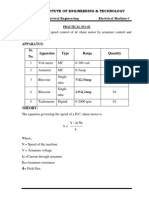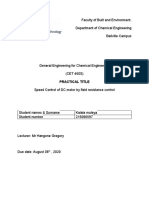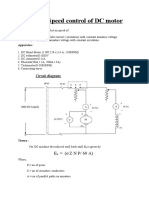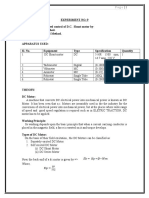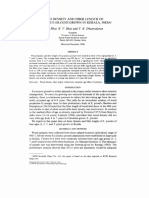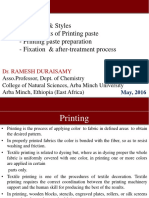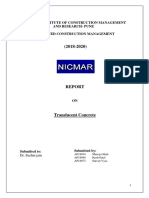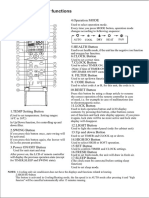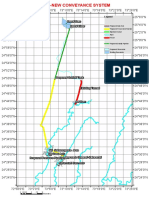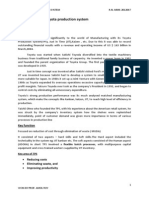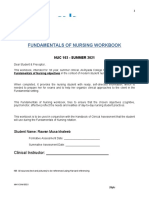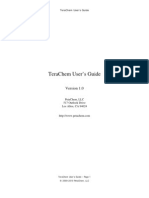Jamalpur Science and Technology
University
Department of Electrical and Electronic Engineering
Lab Report
Electrical Machine I
(Course Code: EEE2112)
Submitted By:
Shad Ebny Wahid
ID: 23111212
Session: 2022-2023
2nd Year, 1st Semester
Submitted To:
Md Mahfuzul Haque
Assistant Lecturer
Department of Electrical
and Electronic Engineering
Date of Submission:
March 17, 2025
�Experiment No: 03
Experiment Name:
Speed Control of a DC Shunt Motor and observation of the existence back emf using field
voltage control.
Objective
• To study the speed control of a DC shunt motor.
• To observe the existence of back EMF and its relationship with field current.
Introduction
A DC shunt motor is a type of DC motor where the field winding is connected in parallel
with the armature winding. The speed of a DC shunt motor can be controlled by varying
the field current or armature voltage. This experiment aims to analyze the speed variation
with respect to field current and to verify the back EMF relationship.
Theory
A DC shunt motor is a type of direct current (DC) motor where the field winding is
connected in parallel (shunt) with the armature winding. This configuration allows for
relatively constant speed under varying load conditions. The speed control of a DC shunt
motor is achieved by varying the field current (IF ) or armature voltage (V ).
Speed Equation of a DC Shunt Motor:
The general speed equation of a DC motor is given by:
K(V − Ia Ra )
N= (1)
ϕ
where:
• N = Speed of the motor (RPM)
• K = Machine constant
• V = Applied armature voltage (Volts)
• Ia = Armature current (Amperes)
• Ra = Armature resistance (Ohms)
• ϕ = Flux per pole, which is proportional to the field current (IF )
Since ϕ is proportional to IF , increasing the field current increases flux, which leads to a
decrease in motor speed due to the inverse relationship between speed and flux.
1
�Back EMF in a DC Shunt Motor
When the armature of a DC motor rotates, it cuts the magnetic field lines and induces an
electromotive force (EMF) in the opposite direction of the applied voltage. This induced
EMF is known as back EMF (Eb ), and it is given by:
Eb = KN ϕ (2)
where:
• Eb = Back EMF (Volts)
• K = Machine constant
• N = Speed of the motor (RPM)
• ϕ = Flux per pole
The back EMF acts as a self-regulating mechanism that limits the armature current.
When the speed decreases, back EMF decreases, allowing more current to flow through
the armature, thereby increasing torque.
Methods of Speed Control
The speed of a DC shunt motor can be controlled using the following methods:
1. Field Control Method: The field resistance is varied using a rheostat to control
the field current (IF ). Increasing IF increases flux, reducing speed.
2. Armature Voltage Control: The applied voltage to the armature is varied to
change the speed. Higher voltage increases speed, while lower voltage decreases it.
3. Armature Resistance Control: Additional resistance is added in series with
the armature circuit to drop voltage and reduce speed. However, this method is
inefficient due to power loss in the resistance.
Speed control of a DC motor is a fundamental aspect of electrical engineering, partic-
ularly in applications where precise control of motor speed is required. One of the most
straightforward and widely used methods for controlling the speed of a DC motor is by
varying the applied voltage, known as armature voltage control. This method relies
on the direct relationship between the voltage supplied to the motor’s armature and its
rotational speed. The principle behind this method is derived from the basic speed equa-
tion of a DC motor, which states that the speed (NN ) of the motor is proportional to the
applied voltage (VV ) and inversely proportional to the magnetic flux (). Mathematically.
In practical applications, armature voltage control is achieved using a variable DC power
supply or a potentiometer to vary the voltage across the motor terminals. As the voltage
increases, the electromotive force (EMF) generated in the armature increases, causing the
motor to rotate faster. Conversely, reducing the voltage decreases the EMF, resulting in
a slower motor speed. This method is particularly effective for controlling speeds below
the motor’s rated voltage, as it provides a linear and predictable relationship between
voltage and speed. However, it is important to note that this method has limitations. At
lower voltages, the motor may experience reduced torque, which can affect its ability to
2
�drive loads effectively. Additionally, the speed cannot be increased beyond the motor’s
rated voltage without risking damage to the motor.
The advantages of voltage-based speed control include its simplicity, cost-effectiveness,
and ability to provide smooth and continuous speed regulation. It is commonly used in
applications such as electric vehicles, conveyor systems, and industrial machinery where
precise speed control is essential. However, for applications requiring higher speeds or
greater torque, other methods such as field flux control or advanced electronic techniques
like pulse-width modulation (PWM) may be more suitable. Despite its limitations, arma-
ture voltage control remains a fundamental and widely used method for speed regulation
in DC motors, offering a clear demonstration of the relationship between electrical inputs
and mechanical outputs in electromechanical systems.
Apparatus Required
Sl No Name Rating Quantity
1 Separately Excited DC Generator 1 Pc(s)
2 DC Motor(For Rotating the Generator) 220V 1 Pc(s)
3 Multimeter 1000V,10A 2 Pc(s)
4 Tachometer 1 Pc
4 Tachometer 1 Pc
4 Connecting Wire As Required
Table 1: Apparatus Table
Experimental Diagram
Figure 1: Circuit Diagram
3
�Procedure
1. Connect the circuit as shown in the diagram.
2. Turn on the mechanically coupled motor.
3. Increase the speed of the motor by increasing the supply voltage of the motor.
4. Note Down the Value of voltage of the multimeter.
5. Construct graph of N vs VT using the collected data.
Data Table
Voltage (V) Current (I)
0 162.05
50 156.87
100 144.90
125 138.09
150 132.11
175 125.93
200 119.75
Table 2: Voltage vs. Current Data
Graph
4
�Report
From the experimental data mentioned above, we can see that the load voltage decreases
with decreasing load current. With decreasing voltage, the current is decreasing from the
beginning. This data can help knowing external load characteristics of DC Generator.
The experiment successfully demonstrated the external characteristics of a separately
excited DC generator. The relationship between the load current and the terminal volt-
age was observed, confirming the theory behind the generator’s behavior under external
load conditions. This theory is significantly important for designing and optimizing DC
generators. However, the experiment was done under the inspection of a teacher as the
ac voltage is potentially dangerous.
Reference
Wikipedia and ChatGPT








